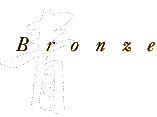


 intaglio
designs before being reassembled around an inner core for
final casting.
intaglio
designs before being reassembled around an inner core for
final casting.
Used first in rituals devoted to worship of the elite's ancestors, and generally buried with the person who had used them, bronze vessels were made in a restricted number of type-forms designed for storing, heating, and drinking wine; cooking and serving food; and holding water for ablutions. The earliest bronze vessels from the Xia and early to mid-Shang periods, made within a limited geographic area, reflect a clear metropolitan style associated with the Yellow River valley. Distinctive regional styles appeared with the expansion of borders during the late Shang and the succeeding Zhou periods.
Although the origins and meanings of the early designs continue to be debated, early Chinese sources are unanimous in their belief that the imagery was auspicious by intent and carried connotations of royal power. Particular note should be taken of the taotie, a semiabstract, animal-like mask with bilateral symmetry around a pair of eyes. This design was one of the earliest to appear and became a permanent part of the decorative repertory.
During the early centuries of the Zhou period, the forms of some vessel types were modified and other types were replaced by new forms, all of which manifests a significant change of function for the vessels. Long inscriptions detail the circumstances under which a given vessel or set of vessels was cast-an official promotion, perhaps, or a grant of land -and conclude with an injunction that the piece be treasured and used forever by the descendants of the maker. The ritual forms were thus no longer used to ensure the continued flow of ancestral blessings but had begun to function as markers of personal status and achievement, a social trend accompanied in politics by the gradual weakening of central authority.
By the beginning of the Warring States period (475-221 BCE), when political power lay in the hands of competing states, the lavish use of gold, silver, and inlays of glass and other precious materials on bronzes corresponds with, on the one hand, their diminishing ritual function and, on the other, a new role: the manifestation and glorification of the power and wealth of their owners. The rise of competing states greatly increased the demand for sets of bronzes as symbols of status and political legitimacy. Increased production was made possible by a number of technical advances, including the use of replicated rather than individually carved patterns and the lost-wax casting process, which allowed the creation of more complex designs.
By the Han dynasty (206 BCE-220 CE), the production of traditional ritual vessels had ceased, and bronze was used to make utilitarian or luxury goods. And by the Tang dynasty (618-907), gold and silver or gilt-bronze had replaced bronze almost completely as the metalware of the elite, probably due to contact with peoples of central and west Asia, where these precious metals had long been valued.